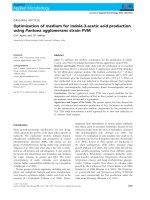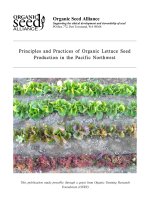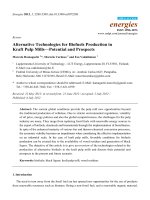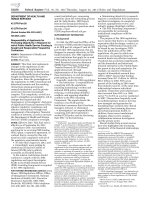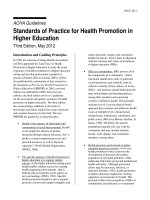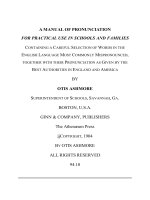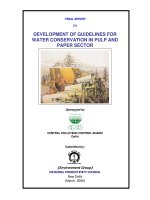Optimization of photobioreactor for astaxanthin production in chlorella zofingiensis
Bạn đang xem bản rút gọn của tài liệu. Xem và tải ngay bản đầy đủ của tài liệu tại đây (1.79 MB, 120 trang )
OPTIMIZATION OF PHOTOBIOREACTOR FOR
ASTAXANTHIN PRODUCTION IN
CHLORELLA ZOFINGIENSIS
FUNG PAK HANG, MARTIN
NATIONAL UNIVERSITY OF SINGAPORE
2010
OPTIMIZATION OF PHOTOBIOREACTOR FOR
ASTAXANTHIN PRODUCTION IN
CHLORELLA ZOFINGIENSIS
FUNG PAK HANG, MARTIN HT091396M
(B. Eng (Hons), NUS)
A THESIS SUBMITTED
FOR THE DEGREE OF MASTER IN ENGINEERING
DIVISION OF ENVIRONMENTAL SCIENCE and
ENGINEERING
NATIONAL UNIVERSITY OF SINGAPORE 2010
Acknowledgment
I would like to express my heartfelt gratitude to my supervisor, Associate Professor Ng
How Yong for his intellectual guidance and invaluable support and advice throughout the
course of this research project.
Sincere thanks are extended to the members of the examination committee, as well as the
external examiners for reviewing this thesis.
I would also like to thank the staff of the Water Science and Technology Laboratory in
the Division of Environmental Science and Engineering; Mr. Chandrasegaran, Ms. Lee
Leng Leng, and Ms. Tan Xiaolan, for their assistance in experimental support and with
lab equipment.
I wish to express my deepest thanks to my family, and my good friends in the lab,
especially Mr. Albert Ng, Ms. Low Siok Ling, Ms. Zang Kai Sai for their support, and for
making laboratory work less arduous than expected. Thanks for making my years in the
lab so memorable!
Optimization of Astaxanthin Production in C. Zofingiensis
Page | i
Abstract
Microalgae have been known to produce commercially valuable carotenoids beneficial to
human health. One of the algal carotenoids that have received a lot of research attention
is astaxanthin. Also known as “king of antioxidant”, astaxanthin is 100 times more than
the antioxidant capacity of that of vitamin E, and 10 times more than that of beta-carotene.
Chlorella Zofingiensis, a strain of green microalgae, has been shown in recent years to be
able to accumulate astaxanthin when exposed to environmental stress. This study
investigated the astaxanthin production capacity of Chlorella Zofingiensis under nitrate,
light
and
temperature
stress
under
a
semi-continuous
turbidostatic
flat-bed
photobioreactor.
A total of 15 configurations consisting of different nitrate concentration and light
intensities were tested in a batch system in phase 1 of the experiment. Growth rates and
astaxanthin contents were monitored. Highest dry mass of 7.55 g/L was obtained at 0.5
g/L of nitrate and at light intensity of 300 umol photon.m-2s-1. It was found that low
nitrate level, coupled with high light intensity, was the key to high cellular accumulation
in C. Zofingiensis. Peak volumetric astaxanthin production was at 7.06 mg/L. Using the
optimum nitrate/light intensity pair, it was further tested in a flat-bed photobioreactor in
semi-continuous mode. Cellular astaxanthin level was at 0.69 mg/g, almost 50% lower
than the batch system, but the growth of C. Zofingiensis biomass was more. Volumetric
astaxanthin production of semi-continuous system was comparable to batch system.
Optimization of Astaxanthin Production in C. Zofingiensis
Page | i
Daily astaxanthin production for continuous system was 21% higher than that of the
batch system.
Overall, the reported data suggests that C. Zofingiensis is an attractive candidate for the
mass production of astaxanthin in continuous reactor, being plausible for selectively
favoring the production of astaxanthin through the adequate management of growth
conditions.
Optimization of Astaxanthin Production in C. Zofingiensis
Page | ii
List of Figures
Figure 1 - 1 Schematic diagram of photosystem ................................................................ 2
Figure 1 - 2 Characteristics absorption spectra of microalgae: a green alga - Dunaliella
tiertiolecta; a diatom. (Kromkamp and Limbeek 1993) Skeletonema costatum and a
cyanobacterium - Anacystis nidulans (Aubroit 1991) ........................................................ 4
Figure 1 - 3 The colorful world of carotenoids, from fruits to seafood. Daily intakes of
carotenoids are known to reduce critical illnesses such as heart, liver and kidney diseases.
............................................................................................................................................. 6
Figure 1 - 4 Global carotenoids market value by product in 2007 and 2015...................... 7
Figure 1 - 5 H. Plauvialis cyst ............................................................................................. 8
Figure 1 - 6 Commercial H. Plauvialis pond ...................................................................... 8
Figure 1 - 7 Algal supplements, in the form of extracted pigments and dry powered form
........................................................................................................................................... 11
Figure 2 - 1 Microscopic image of C. Zofingiensis, showing size from 4-10 µm. ........... 18
Figure 2 - 2 Schematic diagram of photosystem .............................................................. 20
Figure 2 - 3 Suggested mechanism for astaxanthin accumulation. ................................... 21
Optimization of Astaxanthin Production in C. Zofingiensis
Page | iii
Figure 2 - 4 Chlorella vulgaris: observed growth rate versus irradiance level for 25, 30,
35˚C (Dauta, et al. 1990)................................................................................................... 24
Figure 2 - 5 Experimental conditions for phase 1 ............................................................. 32
Figure 2 - 6 Astaxanthin enantiomer 3S, 3’S; 3R,3’S; 3R,3’R; Molecular formula C40H52O4 - Molar mass - 596,84 g/mol ............................................................................. 33
Figure 2 - 7 Typical process flow for the commercial production of natural astaxanthin by
H. pluvialis. ....................................................................................................................... 37
Figure 2 - 8 Review of existing PBR (Ana 2006) ............................................................. 42
Figure 3 - 1 Left: Isometric view of the 3L flat-plate photobioreactor and experimental
set-up from front view of reactor (arrows indicating direction of flow)........................... 51
Figure 3 - 2 Picture of flat-bed algal photobioreactor....................................................... 52
Figure 3 - 3 Ion chromatography system with auto-sampler for measurement of nitrate
concentration ..................................................................................................................... 55
Figure 3 - 4 Spectrophotometer for measurement of algal pigments................................ 56
Figure 3 - 5 Typical absorption spectrum of chlorophyll a, b and total carotenoids. ....... 59
Figure 4 - 1 Initial Growth Curve of C. Zofingiensis........................................................ 60
Figure 4 - 2 Absorbance of C. Zofingiensis was measured at 670 nm using a
spectrophotometer and plotted against dry weight concentration at 10x dilution. ........... 62
Optimization of Astaxanthin Production in C. Zofingiensis
Page | iv
Figure 4 - 3 Growth curves at varying nitrate concentration at 25°C. Batch cultures of C.
Zofingiensis were carried out at nitrate concentration 1, 0.5, 0.25, 0.125 and 0 g/L with
light intensity at 100, 300, 600 µmol m-2 s-1. A total of 15 configurations were tested. ... 63
Figure 4 - 4 specific growth rate was plotted against nitrate concentration at light
intensity 100, 300, 600 µmolm-2 s-1. The initial culture concentration was 2g/L. ........... 64
Figure 4 - 5 C. Zofingiensis at day 0. ................................................................................ 65
Figure 4 - 6 C. Zofingiensis at day 7 under 100 µmol m-2 s-1 and at 0.25 g/L of nitrate
concentration, showing darkening of green colour. .......................................................... 66
Figure 4 - 7 C. Zofingiensis at day 7 under 300 µmol m-2 s-1 and at 0.25 g/L nitrate
concentration, showing mixture of green and red colour. ................................................ 66
Figure 4 - 8 C. Zofingiensis at day 7 under 600 µmol m-2 s-1 and at 0.25g/L of nitrate
concentration , showing mixture of red and black colour ................................................. 67
Figure 4 - 9a Astaxanthin concentration at day 10 was plotted against nitrate
concentration at different light intensity. ; Figure 4 – 9b volumetric astaxanthin content
plotted against nitrate concentration with changing light intensity .................................. 68
Figure 4 -10a Chlorophyll a and b concentration plotted against nitrate concentration with
changing light intensity; Figure 4 – 10b Volumetric chlorophyll a and b concentration
plotted against nitrate concentration with changing light intensity. ……………………70
Figure 4 – 11a Total carotenoids concentration plotted against nitrate concentration with
changing light intensity; Figure 4 – 11b Volumetric total carotenoids concentration
plotted against nitrate concentration with changing light intensity. ……………………71
Optimization of Astaxanthin Production in C. Zofingiensis
Page | v
Figure 4 - 12 Growth curve of photobioreactor operated at turbidostatic mode for 30
days; subculture conducted on day 8, 16, 22 and 30…………………………………… 73
Figure 4 - 13 pigment concentration (mg/g) of C. Zofingiensis represented in percentage
at day 8, 16, 22 and 30 for temperature 22, 25 and 28˚C………………………………. 75
Figure 4 - 14 volumetric pigment concentration (mg/L) of C. Zofingiensis represented in
percentage at day 8, 16, 22 and 30 for temperature 22, 25 and 28˚C…………………... 75
Optimization of Astaxanthin Production in C. Zofingiensis
Page | vi
Nomenclature
Ca
Chlorophyll a concentration
[mgL-1]
Cb
Chlorophyll b concentration
[mgL-1]
Cx
biomass concentration
[g L-1]
g
gravitational acceleration
[ms-2]
μ
specific growth rate
[h-1]
μ max
maximum specific growth rate
[h-1]
ROS
Reactive Oxygen Species
T
absolute temperature
[K]
t
time
[h]
λ
wavelength
[nm]
PFD
photon flux density in PAR range
[μmol photons m-2 s-1]
PAR
photosynthetic active radiation, 400-700 nm
Optimization of Astaxanthin Production in C. Zofingiensis
Page | vii
Abbreviations
Asta
Astaxanthin
Chl
Chlorophyll
Carot Carotenoids
FPR
Flat-plate reactor
Optimization of Astaxanthin Production in C. Zofingiensis
Page | viii
Table of Contents
Acknowledgment ................................................................................................................. i
Abstract ................................................................................................................................ i
List of Figures .................................................................................................................... iii
Nomenclature .................................................................................................................... vii
Abbreviations ................................................................................................................... viii
Table of Contents ............................................................................................................... ix
Chapter 1 Introduction ........................................................................................................ 1
1.1 Photosynthesis ...................................................................................................... 1
1.2
Algal Pigmentations ............................................................................................. 3
1.3 Functions of Carotenoids ..................................................................................... 5
1.4 Commercial Exploration of Algae ....................................................................... 8
1.5
Valuable Products from Microalgae .................................................................. 10
1.6
Challenges Faced by the Algae Industries ......................................................... 12
1.6.1
Limited strains available on large scale farm ............................................. 12
1.6.2
Prohibitive cost ........................................................................................... 13
1.6.3
Lack of industrial scale experiments........................................................... 13
Optimization of Astaxanthin Production in C. Zofingiensis
Page | ix
1.6.4
More research required on new and improved algal strains ....................... 14
1.7 Project Objectives and Scopes ........................................................................... 15
Chapter 2 Literature Review ............................................................................................. 17
2.1 Introduction:............................................................................................................ 17
2.2 Algae of interest: C. Zofingiensis............................................................................ 17
2.3 Algal Fundamentals ................................................................................................ 18
2.4 Mechanism of Astaxanthin accumulation ............................................................... 20
2.5 Factors Affecting Growth of Algae and Astaxanthin Accumulation...................... 21
2.5.1 Temperature ..................................................................................................... 23
2.5.5 Nutrient ............................................................................................................ 25
2.5.2 pH ..................................................................................................................... 27
2.5.3 Illumination ...................................................................................................... 27
2.5.4 Mixing and Turbulence .................................................................................... 29
2.5.6 Gas Transfer ..................................................................................................... 30
2.6 Chemical Structure of Astaxanthin ......................................................................... 32
2.7 Astaxanthin as an Antioxidant ................................................................................ 34
2.8 Industrial Production of Astaxanthin ...................................................................... 35
2.9 Shortcomings of the Current Mass Production System .......................................... 38
2.10 Method of Cultivation of C. Zofingiensis ............................................................. 40
2.11 Photobioreactor Design ......................................................................................... 41
Optimization of Astaxanthin Production in C. Zofingiensis
Page | x
2.12 The Need for Investigation ................................................................................... 44
Chapter 3 Materials and Methods ..................................................................................... 45
3.1 Organism ............................................................................................................ 45
3.1.1
Initial Growth Conditions ........................................................................... 45
3.1.2
Maintenance of microalgae ......................................................................... 47
3.2
Phase 1: Optimization of Algal Growth ............................................................. 47
3.2.1
Experiment Design Overview ..................................................................... 47
3.2.2
Chemicals .................................................................................................... 48
3.2.3
Operating Conditions .................................................................................. 48
3.2.4
Cryopreservation and Recovery of microalgae........................................... 49
3.3
Phase 2: Photobioreactor operation .................................................................... 50
3.3.1
Phase 2 Experiment Design Overview ....................................................... 50
3.3.2
Operational Perimeters................................................................................ 52
3.5
Physical and Analytical methods ....................................................................... 53
3.5.1
Sample Preparation for Determination of Growth Parameters ................... 53
3.5.2 Ion chromatography (IC) ................................................................................. 54
3.5.3
Light Scattering (Turbidity) ........................................................................ 55
3.5.4
Sample Preparation for Determination of Astaxanthin Content ................. 56
3.5.5 Sample Preparation for Determination of Chlorophyll And Total Carotenoids
Content ...................................................................................................................... 57
Optimization of Astaxanthin Production in C. Zofingiensis
Page | xi
Chapter 4 Results and Discussion ..................................................................................... 60
4.1 Experimental Results .............................................................................................. 60
4.1.1 Monitoring of Initial C. Zofingiensis Growth ...................................................... 60
4.1.2 Phase 1: Batch Growth of C. Zofingiensis ........................................................... 62
4.1.2.1 Varying Nitrate Concentration and Light Intensity ...................................... 62
4.1.2.2 Physical Changes of C. Zofingiensis................................................................. 65
4.1.2.3 Pigment Profiles in C. Zofingiensis .............................................................. 67
4.1.2 Phase 2: Semi-Continuous Reactor Operation..................................................... 73
4.1.2.1 Growth Rate with Changing Temperature .................................................... 73
4.1.2.2 Pigment Profile with Changing Temperature ............................................... 74
4.2 Discussion ............................................................................................................... 77
4.2.1 Nitrate Concentration Effect ............................................................................ 77
4.2.2 Light Effect ...................................................................................................... 78
4.2.3 Temperature Effect .......................................................................................... 81
4.2.4 Relationship between Algal Pigments ............................................................. 83
4.2.5 High Light and High Temperature: Practical Implication ............................... 84
4.2.6 Optimization of Reactor ................................................................................... 85
4.2.7 Liquid Mixing Rate .......................................................................................... 86
4.2.8 Hydrodynamic Stress and Cell Death .............................................................. 87
Chapter 5 Conclusions and Recommendations................................................................. 88
Optimization of Astaxanthin Production in C. Zofingiensis
Page | xii
5.1 Conclusions ............................................................................................................. 88
5.2 Recommendations and Direction for Future Research ........................................... 92
Chapter 6 References ........................................................................................................ 94
Optimization of Astaxanthin Production in C. Zofingiensis
Page | xiii
Chapter 1
Introduction
Chapter 1 Introduction
Microalgae and cyanobacteria, also known as blue-green algae, are found widely in our
bio-sphere. They contribute approximately 40-50% of the oxygen in the atmosphere and
they are the original source of fossil fuel. (M. Borowitzka 1997)They are also at the
bottom of the food chain, directly and indirectly linked to our food security.
1.1
Photosynthesis
Microalgae and cyanobacteria are oxygenic photoautotrophic microorganism. They are
able to use sunlight to metabolize carbon dioxide (CO2) inside CH2O under the liberation
of oxygen (O2). CH2O are the building blocks for algal growth. The universal equation of
photosynthesis is presented below:
Equation 1 - 1
CO2 + H2O + photon Æ CH2O + O2
Essentially, microalgae convert light energy into chemical energy via the formation of
chemical bonds. The basic unit of photosynthetic apparatus is the photosystem (PS).
Photons are absorbed by carotenoids and chlorophyll pigments of the photosystem
antenna complex. In Figure 1 - 1, the operation of PS is shown. The excitation energy is
funneled through the pigment bed towards the reaction centre (P680), which is brought to
1.
Optimization of Astaxanthin Production in C. Zofingiensis
Page | 1
Chapter 1
Introduction
a higher energy level (P680*). Almost 95-99% of the excitations can be transferred to the
reaction center. The transfer of energy is highly efficient because the excitations “fall”
inside an “energy hold” with the reaction centre at the bottom. During the transport, the
excitations lose some energy and this is the reason why reverse transport is not possible.
Inside the reaction centre, the remaining excitation energy activates the reaction centre
(P680 Æ P680*) by promoting an electron from the highest-energy filled orbital to the
lowest-energy unfilled orbital. The electron is quickly transferred to an acceptor
generating an oxidant and reductant, respectively, and this process is called charged
separation (Richmond, 2004).
Figure 1 - 1 Schematic diagram of photosystem (Lawlor 2001)
1.
Optimization of Astaxanthin Production in C. Zofingiensis
Page | 2
Chapter 1
1.2
Introduction
Algal Pigmentations
Algae pigments are chemical compounds which reflect only certain wavelengths of
visible light. This makes them appear "colorful". Flowers, corals, and even animal skin
contain pigments, which give them their colors. More important than their reflection of
light is the ability of pigments to absorb certain wavelengths.
All microalgae contain three major classes of photosynthetic pigments: chlorophylls,
carotenoids (carotenes and xanthophylls) and phycobilins. The different division of
microalgae is characterized by a specific pigment composition. A considerable diversity
exists among the carotanoid and chlorophyll pigments. Chlorophylls and carotenes are
generally fat-soluble molecules and can be extracted from thylakoid membranes with
organic solvents such as acetone and methanol. The phycobilins and peridinin, in contrast,
are water-soluble and can be extracted from algal tissues after the organic solvent
extraction of chlorophyll in those tissues.
In
Figure 1 - 2, the characteristic absorption spectra of a Chlorohyta (green alga),
Chrysophyta (diatoms) and a cyanophyta (cyanobacteria) are shown. The absorption
peaks between 650–700 nm which is the red region, are caused by chlorophyll absorption.
Carotenoids absorb most strongly in the 400-500 nm and transfer the excitation energy to
1.
Optimization of Astaxanthin Production in C. Zofingiensis
Page | 3
Chapter 1
Introduction
the chlorophylls, making photosynthesis efficient over a wider range of wavelengths, In
addition to chlorophylls and carotenoids, cyanobacteria have pigments called
phycobilisomes, which enables them to absorb 600-650 nm more strongly than other
strains of microalgae.
Figure 1 - 2 Characteristics absorption spectra of microalgae: a green alga - Dunaliella tiertiolecta; a diatom.
(Kromkamp and Limbeek 1993) Skeletonema costatum and a cyanobacterium - Anacystis nidulans (Aubroit
1991)
1.
Optimization of Astaxanthin Production in C. Zofingiensis
Page | 4
Chapter 1
1.3
Introduction
Functions of Carotenoids
Carotenoids cannot transfer sunlight energy directly to the photosynthetic pathway, but
must pass their absorbed energy to chlorophyll. For this reason, they are called accessory
pigments. In addition to light harvesting, carotenoids have other functions in the cell.
They protect the PS under unfavorable environmental conditions, such as high light
intensity and high salinity. In the case of high light intensity, an overdose of excitation
energy can lead to the production of toxic species (i.e. reactive oxygen species (ROS))
and damage of the PS. Carotenoids are able to scavenge these ROS. An overdose of
excitation energy can be dissipated as heat by Carotenoids in the antenna complex, which
in turn prevents the formation of ROS (Britton 1995, Miki 1991).
Scientists have paid special attention to carotenoids found in higher plants and algae, as
well as other photosynthetic organisms such as animals, fungi and plants. Carotenoids are
responsible for the red, orange and yellow color of plant leaves, fruits, flowers, fish flesh
and crustacean shells. These Carotenoids (e.g. astaxanthin) are accumulated and
exploited by commercial algal farming. These compounds with antioxidant ability are
highly valued in the market, and it has been proven that adequate intake of carotenoids is
able to prevent degenerative diseases. More details can be found in chapter 2. Betacarotenoids, xanthophylls, astaxanthin, cantaxanthin, and lutein are the major carotenoids
with commercial interest (Richmond, 1986).
1.
Optimization of Astaxanthin Production in C. Zofingiensis
Page | 5
Chapter 1
Introduction
Figure 1 - 3 The colorful world of carotenoids, from fruits to seafood. Daily intakes of carotenoids are known to
reduce critical illnesses such as heart, liver and kidney diseases.
The carotenoids of interest, astaxanthin, are known to be the most powerful antioxidant
available nowadays. Astaxanthin sells for approximately US$2,500 kg−1 with an annual
worldwide aquaculture market estimated at US$200 million (Cysewski 2004). Projections
for 2015 of global astaxanthin market rise to US$257 million (BCC Research 2008).
1.
Optimization of Astaxanthin Production in C. Zofingiensis
Page | 6
Chapter 1
Introduction
Figure 1 - 4 Global carotenoids market value by product in 2007 and 2015 (BCC Research 2008)
Most of the astaxanthin available in the market is synthetically-derived. However,
consumer’s demand for natural products provides an excellent opportunity for the natural
carotenoids, and Haematococcus pluvialis represents the richest biological source of this
pigment (Lorenz and Cysewski, 2003). It is now cultivated at large scale by several
companies, and being used as commercial feed for salmon and rainbow trout to enhance
their commercial value (Torrissen 1986). The Chlorophyte alga Haematococcus pluvialis
is believed to accumulate the highest levels of astaxanthin in nature. Commercially
grown H. pluvialis can accumulate 0.30 g of astaxanthin per kg of dry biomass (Burick
1991, Aflalo, et al. 2007).
1.
Optimization of Astaxanthin Production in C. Zofingiensis
Page | 7
Chapter 1
Introduction
Figure 1 - 5 H. Plauvialis cyst (Bar, et al. 1995)
Figure 1 - 6 Commercial H. Plauvialis pond (Ausich 1997)
1.4
Commercial Exploration of Algae
In the early 1950’s, the increase in the world’s population and predictions of an
insufficient protein supply led to a search for alternative and unconventional protein
sources. Valuable biologically active substances from the algae stood out as a good
candidate for this purpose.
1.
Optimization of Astaxanthin Production in C. Zofingiensis
Page | 8
Chapter 1
Introduction
Commercial large-scale culture of microalgae started in the 1960’s in Japan with the
culture of Chlorella by Nihon Chlorella. It was followed by the establishment of an
Arthrospira harvesting and culturing facility in Lake Texcoco, Mexico. The first
aquaculture field also appeared in the 1970’s. By 1980, there were 46 large-scale
factories in Asia producing more than 1000 kg of microalgae (mainly Chlorella) per
month. The commercial production of Dunaliella salina, as a source of β-carotene,
became the third major microalgal industry when production facilities were established
by Western Biotechnology (Hutt Lagoon, Australia) and Betatene (Whyalla, Australia)
(now Cognis Nutrition and Health) in 1986 (Lee 1997). These were soon followed by
other commercial plants in Israel and the USA. The same as that of these algae, the largescale production of cyanobacteria (blue-green algae) began in India at about the same
time (Ausich 1997).
The Aquatic Species program conducted by United States National Renewable Energy
Laboratory, Department of Energy (DOE) has the purpose of identifying potential algae
species for the production of biodiesel at large scale. This program was initiated because
the price of energy, specifically crude oil, was traded at historical high price and was
threatening the livelihood of the average citizen. To strengthen energy security, DOE had
looked into various energy production methods, and one of the most promising field was
algal biotechnology. Over 200 laboratories over U.S. were involved in this project and
1.
Optimization of Astaxanthin Production in C. Zofingiensis
Page | 9
